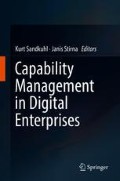Abstract
Enterprise Modelling (EM) is an activity where an integrated model describing different aspects of an enterprise is created. An enterprise model consists of a number of related “sub-models” or perspectives, each describing the enterprise from a particular view, for example, processes, business rules, goals, actors, and concepts/information/data. The purpose of using EM in the context of capability management is to capture and document the existing organizational design. The overall vision of capability management approaches, such as Capability-Driven Development (CDD), is to use (and update if necessary) the enterprise models that the organization already has for capability design. However, if an organization does not have existing models or their use is deemed impractical (e.g., they are severely out of date or the quality of models is below acceptable), new models need to be created. The chapter gives an introduction to the topic of Enterprise Modelling, including perspectives captured in enterprise models, a typical modelling process, and existing modelling methods.
Access this chapter
Tax calculation will be finalised at checkout
Purchases are for personal use only
Preview
Unable to display preview. Download preview PDF.
References
Vernadat, F.: Enterprise Modelling and Integration. Chapman & Hall, London (1996)
Lillehagen, F., Krogstie, J.: Active Knowledge Modelling of Enterprises. Springer, Berlin (2009)
Sandkuhl, K., Stirna, J., Persson, A., Wißotzki, M.: Enterprise Modeling – Tackling Business Challenges with the 4EM Method. The Enterprise Engineering Series. Springer, Heidelberg (2014)
Dietz, J.L.G.: Enterprise Ontology – Theory and Methodology. Springer, Berlin (2006)
Fox, M.S., Gruninger, M.: Enterprise Modeling. AI Magazine 19(3) (1998)
Chen, P.: The entity-relationship model – toward a unified view of data. ACM Trans. Database Syst. 1(1), 9–36 (1976). https://doi.org/10.1145/320434.320440
OMG: OMG Unified Modeling Language TM (OMG UML), version 2.5 (2015). http://www.omg.org/spec/UML/2.5
Persson, A., Stirna, J.: An explorative study into the influence of business goals on the practical use of Enterprise Modelling methods and tools. In: Tenth International Conference on Information Systems Development (ISD2001), Royal Holloway, University of London, 5–7 Sept 2001
Bubenko, Jr., J.A., Persson, A., Stirna, J.: An intentional perspective on enterprise modeling. In: Salinesi, C., Nurcan, S., Souveyet, C., Ralyté, J. (eds.) An Intentional Perspective on Enterprise Modeling. Springer, Heidelberg (2010)
Persson, A., Stirna, J.: Towards defining a competence profile for the enterprise modeling practitioner. In: The 3rd IFIP WG8.1 Working Conference on the Practice of Enterprise Modelling (PoEM2010), Delft, The Netherlands, November 2010. LNBIP vol. 68. Springer, Heidelberg (2010)
Scheer, A.-W., Nüttgens, M.: ARIS architecture and reference models for business process management. In: van der Aalst, W.M.P., Desel, J., Oberweis, A. (eds.) Business Process Management—Models, Techniques, and Empirical Studies. LNCS, vol. 1806. Springer, Heidelberg (2000)
Josey, A.: ArchiMate® 2.1–A Pocket Guide. Van Haren (2013)
Frank, U.: MEMO Organisation Modeling Language (1): Focus on Organisational Structure. ICB-Research Report No. 48. University Duisburg-Essen (2011)
Karagiannis, D., Grossmann, W., Höfferer, P.: Open Model Initiative—A Feasibility Study. University of Vienna, Vienna (2008). http://cms.dke.univie.ac.at/uploads/media/Open_Models_Feasibility_Study_SEPT_2008.pdf
F3-Consortium: F3 Reference Manual. ESPRIT III Project 6612, SISU, Sweden (1994)
Bubenko, Jr., J.A., Stirna, J., Brash, D.: EKD User Guide. Department of Computer and Systems Sciences, Royal Institute of Technology, Stockholm (1998)
Loucopoulos, P., Kavakli, V., Prekas, N., Rolland, C., Grosz, G., Nurcan, S.: Using the EKD Approach: The Modelling Component. UMIST, Manchester (1997)
Bubenko, Jr., J.A., Persson, A., Stirna, J.: User Guide of the Knowledge Management Approach Using Enterprise Knowledge Patterns. IST Programme Project Hypermedia and Pattern Based Knowledge Management for Smart Organisations, no. IST-2000-28401. KTH, Sweden (2001). http://www.dsv.su.se/~js/ekd_user_guide.html
Stirna, J., Persson, A.: Enterprise Modeling: Facilitating the Process and the People. Springer, Berlin (2018)
Author information
Authors and Affiliations
Corresponding author
Editor information
Editors and Affiliations
Rights and permissions
Copyright information
© 2018 Springer International Publishing AG, part of Springer Nature
About this chapter
Cite this chapter
Stirna, J., Sandkuhl, K. (2018). Enterprise Modelling: Establishing the Fundament for Capability Management. In: Sandkuhl, K., Stirna, J. (eds) Capability Management in Digital Enterprises. Springer, Cham. https://doi.org/10.1007/978-3-319-90424-5_5
Download citation
DOI: https://doi.org/10.1007/978-3-319-90424-5_5
Published:
Publisher Name: Springer, Cham
Print ISBN: 978-3-319-90423-8
Online ISBN: 978-3-319-90424-5
eBook Packages: Computer ScienceComputer Science (R0)

